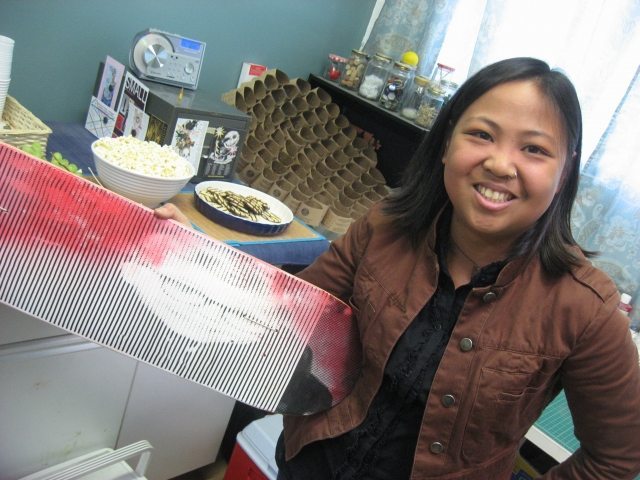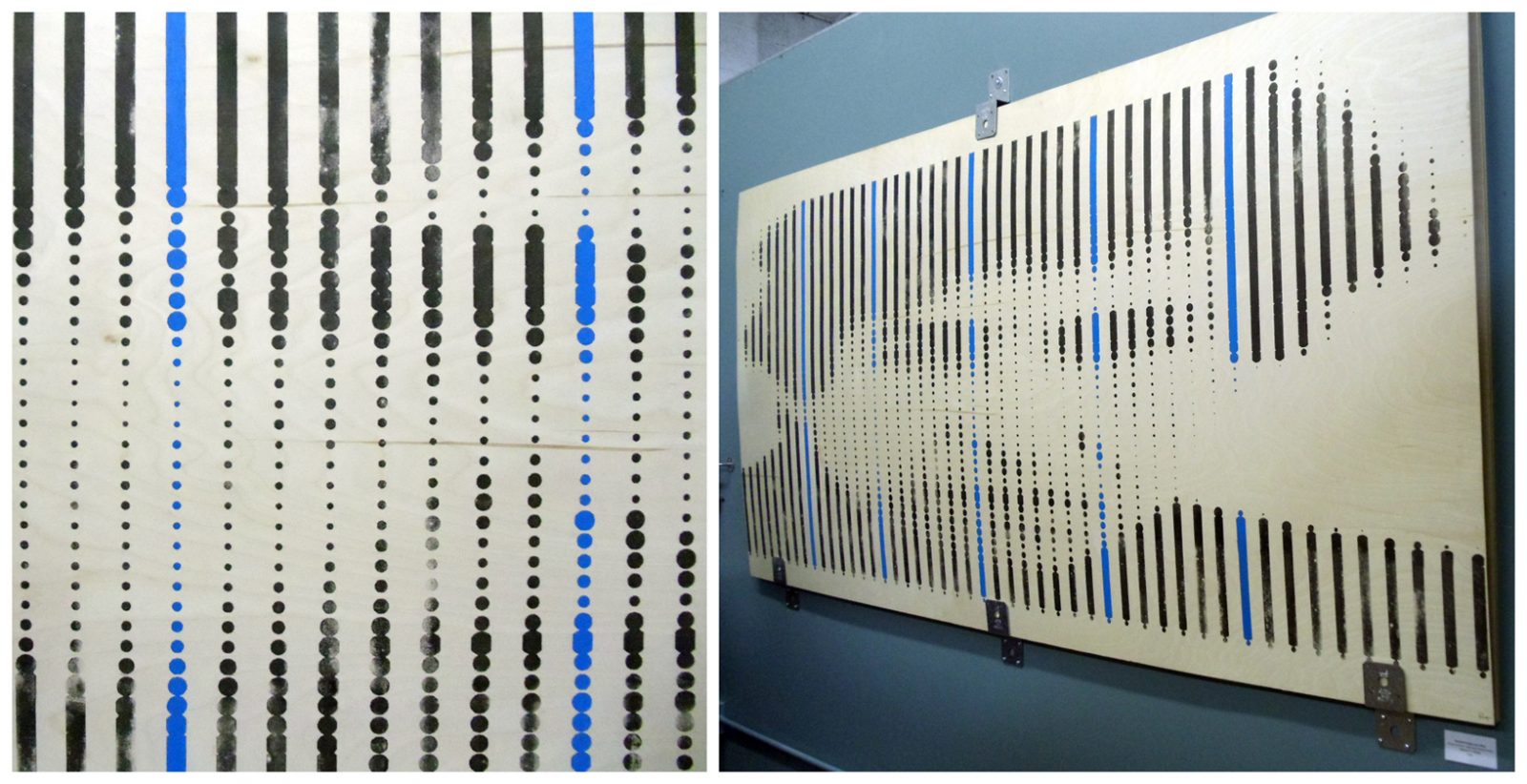Margaret Tarampi’s work has aggressive, boundary-transgressing roots, infiltrating the rich soil of multiple disciplines and unfurling into something that owes a much to engineering and science as it does to the traditional concept of “art.” Originally from Pennsylvania, Tarampi graduated from Carnegie Mellon with a degree in architecture, studied for her master’s at Virginia Tech, and headed to the University of Utah, where she is currently pursuing a PhD in psychology. With a blend of art, engineering, and science in her tool kit, the point of curiosity in her work remains the human element. A master thesis titled “Neuro-architecture: How design designs us” indicates how Tarampi’s underlying interest in understanding people fuels and unites her intellectual and artistic pursuits. Her latest works, We Are Salt Lake, a series of “Gestalt Portraits”of noteable Salt Lake subjects, provides an excellent example of work that is part art, part science, part optical illusion, while focusing on the individuality and humanity of the subjects. Learn more about how Tarampi uses science to feed art, and about her experimental method of making a finished piece after the jump.
 Photo by Gavin SheehanTarampi’s work is strongly influenced by her multidisciplinary interests, down to her take on the perenial “what is art?” issue:
Photo by Gavin SheehanTarampi’s work is strongly influenced by her multidisciplinary interests, down to her take on the perenial “what is art?” issue:
For me, art is something that makes you reconsider your world, anything that makes you think about the beliefs or assumptions you hold
about reality, in whatever capacity. Art always interested me, even as a child, and was always a pursuit and a passion of mine. As I’ve gone through different parts of my life, my work was heavily influenced by what I was doing at the time, and is now very much influenced by my studies in psychology.
I’m going into the sixth year of my PhD; three or four years ago, I was getting a foundation in research on perceptual psychology, and there are so many really interesting concepts that inspired me to pursue them artistically. My last body of work has been influenced by the work of Gestalt psychologists, and the idea that the whole is greater than the sum of its parts, and the psychology of how we organize the world—if we think about all of the things that are in our environment we have to organize them to make sense of them, by proximity, by similar shape, or by similar color.
It made me wonder if you could put those principals of grouping in conflict with each other, and if this would influence how someone would view them. I spent some time experimenting artistically, trying to do this, and didn’t have much luck. I figured out a way to do this after I read some scientific papers about grouping, and it evolved into this latest work, which, when you view it from straight on, forces the viewer to group the elements in a certain way, but when viewed from the side allows the viewer to see the portrait itself as the spacing that I’ve introduced gets perceptually closer.
If Tarampi feels that the her artist explorations have more freedom than those in psychology, constrained as it is by the scientific method, she is nonetheless enthusiastic about their ability to complement each other.
Throughout history there were so many aspects that artists discovered or explored that scientists later support—linear perspective, occlusion, depth—for me they are very much interlinked, and my research work is better for being able to understand how other fields have approached a question—it provides different directions to try. For a long time, art and science were separate parts of my life, and they are starting to have this really wonderful overlap as I’m seeing how they can spark creative ways of viewing the world scientifically and artistically.
And it certainly seems that Tarampi’s out-of-field endeavors pave the way for her artistic avenues of exploration, as she brings a little bit of the science experiment and a little of the architectural drafting board to her drawing table. Photo by Jennifer Leahy Photography
Photo by Jennifer Leahy Photography
For this last show, I have this book where I just write down ideas for pieces, and I’ll take one of those idea and start conceptualizing it. Most of my process is preparatory: rather than just making it, I’ll think about the subject, and about the imagery for it, and I’ll spend a great deal of time playing with ideas digitally in different programs, until the idea has the visual power to do what I hope it will do. So I’d say 75% of the artistic process is conceptualizing and manipulating digitally in order to decide on the right medium to realize the idea in. In my last show, I tried to choose a medium and an aesthetic look that was reflective of the individual I was doing the portrait of, so that the style itself was a unifying factor, and the identity and personality was reflected in how it was executed. Sometimes I’ll make smaller pieces, especially if I’m trying to find a new way to manipulate someone’s perception of the piece, and I’ll make adjustments using that. I like working large, though; all of my pieces were four feet by five or larger. At that scale it gives you an idea of how the piece is working, but I have a really small studio, so I end up working outside or in cramped corners.
The scale completely changes the way you see the image, so trying to figure out that right overall size and spacing is what I try to work towards, as well as how many other things I can introduce and still let the viewer see the greater whole—I want to push it to the boundary. When I first started to explore this idea I was mostly using color. I found that color really didn’t influence how we looked at it as much as how close things are to one another. I realized I could use color to emphasize the abstract nature when viewed from the front, but wouldn’t interfere with how its viewed from the side. I went through months of color exploration cto to get effect that I wanted.
Tarampi is equally enthusiastic about the art scene here in Salt Lake, noting both the accepting, supportive atmosphere that other artists provide, and the public’s positive participation in events like the monthly Gallery Stroll. There isn’t much more local artists could ask for, although Tarampi notes that it might be of benefit to have a larger art museum in the city, as the art scene can be a little fragmented with galleries and artists’ collaborative spaces but no central place where it all intersects.
Every week I’m learning about new local artists, and I’m part of the local art community! But to be part of the art community, to learn to navigate it, is certainly something I’d encourage everyone to do, because there are so many great artists in Salt Lake. I have a studio at Poor Yorick, and I find many of the present and past artists there inspiring, and mentally engaging, with different people influencing me in different ways. The abstract, minimalist work of Paul Vincent Bernard, or Denise Crane had an influence on the concept of trying to say a lot with a little. I’ve had a lot of great conversations with Amy Caron about art and science, and about process. And Justin Wheatley has been a great inspiration, as well as a support in my artistic pursuits.
 Photo by Jennifer Leahy Photography
Photo by Jennifer Leahy Photography
If you’re interested in staying up-to-date on Tarampi’s upcoming work, you can check out her site, like her page on Facebook at www.facebook.com/mtarampi, check out Poor Yorick’s page, or mark some of Tarampi’s upcoming fall shows on your calendar:
Poor Yorick Fall 2012 Open Studio
Poor Yorick Studios, 126 Crystal Ave (2590 South), South Salt Lake
Typically the fourth weekend of September
The 24 Hour Art Show
The Hive Gallery, Trolley Square
October 6, 2012
E Pluribus Unum
Tippetts Gallery, Utah State University
October 17–November 9, 2012

